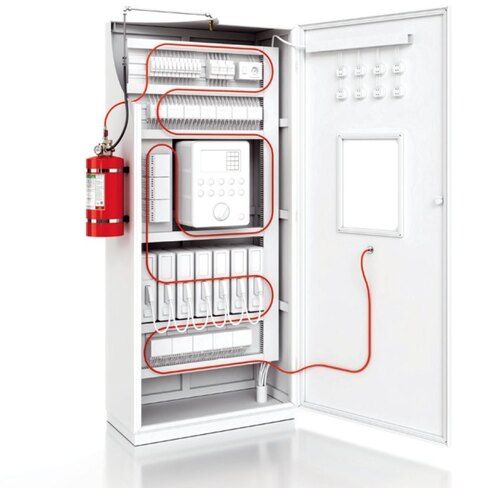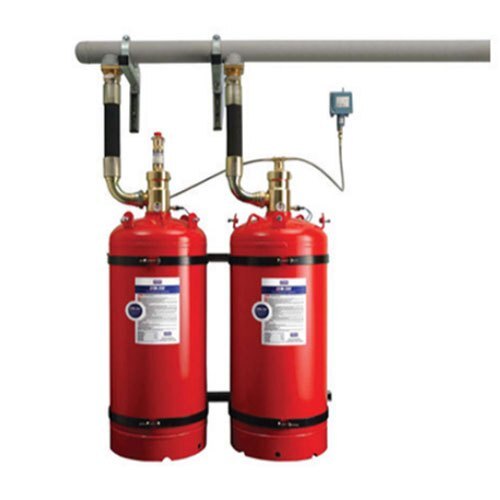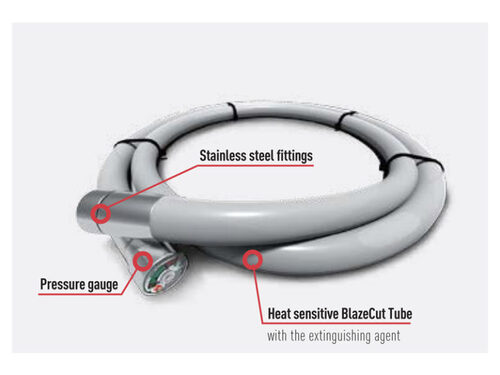- Home Page
- Company Profile
-
Our Products
- Fire Suppression Systems
- Hfc 227ea Auto Fire Extinguishing System
- Hfc227ea Total Flooding System
- Clean Agent Cylinderless System for Car
- Wind Turbine Fire Detection and Suppression System
- Vehicle Fire Protection System
- Fire Extinguishing System For Electrical Cabinets
- Aerosol Based Fire Suppression System
- Cylinder Less Tube Based Fire Detection Suppression Systems
- Hfc227ea Clean Agent Fire Extinguishers
- Carbon Steel Fm 200 Fire Suppression System
- Direct Tube Based Fire Suppression System
- Novac 1230 Fire Flooding Systems
- Clean Agent Fire Suppression System
- Heat Sensing Tube
- Clean Agent Cylinderless System
- Modular Clean Agent HFC236fa Extinguishers
- FK 5112 Suppression System
- Hfc 227ea Based Fire Suppression System
- Novec 1230 Flooding System
- Aerosol Fire Suppression System
- Dual Agent Retardant fire Suppression System
- Fire Suppression For Power Generators
- Car Fire Protection System
- Novec 1230 Clean Agent Suppression Systems
- High Voltage Transformer Fire Suppression System
- FM200 Fire Suppression System
- Mild Steel Novec 1230 Fire Suppression System
- Novec 1230 Fire Suppression System
- Clean Agent Fire Suppression System for Wind Turbine
- Bus Engine Fire Protection System
- Fire Trace System
- SEVO Tubing Suppression System
- Fire Detection And Fire Suppression System
- Heavy Vehicle Fire Suppression Systems
- Fire Sprinkler System Installation Service
- Vehicle Fire Suppression System
- Pre Engineered Fire Suppression System
- Server Rack Fire Suppression System
- Fire Suppression System (Capacitor Panel)
- Mild Steel Fire Suppression Systems
- Electrical Panel Detection Suppression System
- Fire Detection Tube Suppression System
- Fire Extinguishing System For Electrical Panel
- Electrical Panel Gas Suppression System
- Novec 1230 Fire Suppression System for Industrial
- Fm200 Gas Based Fire Suppression Systems
- FM200 Gas Based Fire Suppression Systems For Wind Turbines
- Tube Based Fire Suppression System
- Novec 1230 Fire Gas Suppression System For Electrical Panel
- Novec 1230 Fire Extinguishing System
- Novec 1230 Gas Suppression System For Wind Turbine Fire Suppression System
- Nitrogen Injection Transformer Fire Protection System
- Electrical Panel Fire Suppression System
- Dual Agent Retardant Fire Suppression System
- Diffusible FE36 Fire Suppression System
- Hazardous Cabinets Fire Suppression System
- Chemical Fire Suppression Systems
- Nitrogen NITFP System
- Automatic Fire Detection and Suppression System
- Novec 1230 Fire Suppression Systems
- Fire Suppression For Wind Turbines
- Bladder Tank Proportioning System
- Electrical Panel Fire Suppression
- Fk 5112 Fire Suppression System
- Fire Extinguishing Systems
- Fire Alarms And Detection Systems
- White Addressable Duct Detector
- UV IR Flame Detector
- Agni Sounder Hooter
- Addressable Fire Alarm System
- Fire Alarm System Amc Service
- Conventional Fire Alarm System
- Digital Addressable Fire Alarm System
- Aspirating Systems Smoke Detectors
- Agni Addressable Security Fire Alarm
- Fire Detection And Fire Alarm System
- Uv Ir Flame Detector System
- Ravel 2 zone Conventional Fire Alarm System
- Addressable Photoelectric Duct Detector
- Fire Alarm Sounder
- Fire Response Indicator
- Vesda Aspirating Smoke Detection System
- 4 Zone Addressable Fire Alarm System
- Ravel 4 zone Conventional Fire Alarm System
- Fire Detection Fire Alarm System
- Co2 Flooding/Suppression System
- Co2 Based Fire Suppression Systems
- CO2 Suppression System
- CO2 Fire Flooding
- Automatic Pipeline Co2 Fire Suppression System
- Co2 Fire Flooding System
- Co2 Cylinder Fire Suppression System
- In Direct CO2 Flooding System
- High Pressure Co2 Automatic Fire Extinguishing System
- Automatic Co2 Flooding System
- Automatic CO2 Flooding System
- Gas Based Co2 Flooding System
- Co2 Gas Fire Suppression System
- ELECTRICAL PANEL CO2 FLOODING SYSTEM
- Automatic Pipeline CO2 Fire Suppression System
- Co2 Fire Suppression System
- Passive Fire Protection
- Fire Extinguishers
- Twin Trolley Type Fire Extinguisher
- Co2 Fire Extinguisher Refilling Service
- Clean Agent Type Fire Extinguisher
- Amc For Fire Fighting System
- Co2 type fire Extinguisher
- Mild Steel Wet Chemical Fire Extinguisher
- Carbon Steel Abc Fire Extinguisher
- Automatic Ceiling Mounted D Type Fire Extinguisher
- Water Spray Sprinkler Systems
- Kanex Fire Extinguishers
- Fe36 Clean Agent Fire Extinguisher
- Modular Dry Chemical Powder Extinguishers
- Kitchen Fire Suppression System
- Kitchen Fire Suppression System
- Mild Steel Kitchen Fire Suppression
- Kitchen Hood Fire Suppression System
- Automatic Kitchen Fire Extinguishing System
- Kitchen Fire Extinguisher
- kitchen Nozzle Fire Suppression System
- Restaurant Kitchen Fire Suppression System
- Fire Suppression System For Commercial Kitchen
- Commercial Kitchen Fire Suppression System
- HW & MV Fire Protection System
- Commercial Gas Leak Detector
- Medium Velocity Water Spray System (MVWS)
- Transformer Fire Protection System
- Transformer Fire Prevention System
- Transformer Fire Suppression Systems
- Conveyor belt system fire protection system
- Nitrogen Injection Fire Protection System For Transformer
- High Velocity Water Spray System (HVWS)
- Fire Suppression Accessories
- Fire Hydrant System
- Clean Agent Gas Refilling
- Fire Fighting Foams
- Smoke Detector
- Ravel Beam Smoke Detector
- Addressable Photoelectric Smoke Detector
- Addressable Smoke Detector
- Fire Alarm Addressable Smoke Detector
- Battery Addressable Smoke Detector
- Polycarbonate Smoke Detector
- Agni Smoke Detector
- Conventional Optical Smoke Detectors
- Addressable Duct Smoke Detector
- Agni Wireless Smoke Detector
- White Polycarbonate Smoke Detector
- Manual Call Point
- Fire Retardant Fabric
- Fire Alarm Control Panel
- Heat Detector
- Beam Detectors
- Fire Door
- HW&MV Fire Protection
- Fire Cable Coating
- Fire Cable
- Public Address Systems
- Hydraulic Hose
- Fire Suppression Systems
- Contact Us

Pre Engineered Fire Suppression System
65000 INR/Set
Product Details:
X
Pre Engineered Fire Suppression System Price and Quantity
- 20 Set
- 64000.00 - 65000.00 INR/Set
- 65000 INR/Set
Pre Engineered Fire Suppression System Trade Information
- Cheque
- Asia
- All India
Product Description
A Pre-Engineered Fire Suppression System (PESS) is a specialized fire protection system designed to automatically detect and suppress fires in various types of environments, such as industrial facilities, commercial kitchens, server rooms, and more. These systems are pre-designed and pre-engineered for specific applications, making them efficient and cost-effective solutions for fire protection.
Here are some key components and features of a typical Pre-Engineered Fire Suppression System:
1. Fire Detection: PESS typically includes fire detection devices, such as heat detectors, smoke detectors, or flame detectors. These devices monitor the area for signs of a fire and trigger the suppression system when a fire is detected.
2. Suppression Agent: The system employs a specific fire suppression agent, which can vary based on the type of fire it's designed to combat. Common agents include clean agents like FM-200 or Novec 1230 for electrical and sensitive equipment fires, wet or dry chemical agents for kitchen and industrial fires, and water-based agents like sprinklers for general fire protection.
3. Control Panel: PESS is controlled by a central control panel. When a fire is detected, the control panel activates the suppression system and may also provide alarms and alerts to notify personnel.
4. Distribution System: The distribution system is responsible for delivering the fire suppression agent to the protected area. This can include pipes, nozzles, and other components designed to evenly distribute the agent for effective suppression.
5. Actuation Method: PESS can be actuated automatically when the fire detection system senses a fire, or it can be manually triggered by individuals on-site using pull stations or manual release mechanisms.
6. Gas Storage Containers: In the case of gaseous fire suppression agents like FM-200 or Novec 1230, the system includes storage containers for the agent. These containers are pressurized and release the agent when activated.
7. Maintenance and Inspection: Regular maintenance and inspection are crucial for PESS to ensure its reliability. These systems typically require periodic testing, inspection, and refilling of suppression agents as needed.
8. Compliance: Pre-Engineered Fire Suppression Systems must comply with relevant fire codes and standards, such as those established by the National Fire Protection Association (NFPA) in the United States.
Pre-Engineered Fire Suppression Systems are designed to quickly and effectively suppress fires, limiting damage to property and protecting lives. They are commonly used in settings where traditional fire sprinkler systems may not be suitable due to the nature of the environment or the presence of valuable equipment that could be damaged by water.
Tell us about your requirement

Price:
Quantity
Select Unit
- 50
- 100
- 200
- 250
- 500
- 1000+
Additional detail
Mobile number
Email
Other Products in 'Fire Suppression Systems' category
" We mainly want inquiries from Gujarat, Rajasthan, Madhya Pradesh, Maharashtra, Goa. "






 Call Me Free
Call Me Free
 English
English Spanish
Spanish French
French German
German Italian
Italian Chinese (Simplified)
Chinese (Simplified) Japanese
Japanese Korean
Korean Arabic
Arabic Portuguese
Portuguese